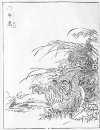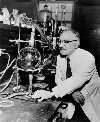 Golden Days is a celebration in Fairbanks, Alaska, of the discovery of gold there on July 22, 1902, and the Gold Rush days that followed. This is the largest summertime event in Alaska. The week of activities includes “Fairbanks in Bloom,” billed as the farthest-north flower show, a rubber ducky race, beard and hairy-leg contests, drag races, a golf tournament, concerts, and a grand parade. There’s also a Felix Pedro look-alike contest. Felix Pedrone (remembered as Felix Pedro) was the Italian immigrant who first found gold on a creek near what is now Fairbanks. Discuss
Golden Days is a celebration in Fairbanks, Alaska, of the discovery of gold there on July 22, 1902, and the Gold Rush days that followed. This is the largest summertime event in Alaska. The week of activities includes “Fairbanks in Bloom,” billed as the farthest-north flower show, a rubber ducky race, beard and hairy-leg contests, drag races, a golf tournament, concerts, and a grand parade. There’s also a Felix Pedro look-alike contest. Felix Pedrone (remembered as Felix Pedro) was the Italian immigrant who first found gold on a creek near what is now Fairbanks. Discuss
Source: The Free Dictionary
 In 1967, racial tensions spurred by high unemployment rates and poor housing conditions in Detroit exploded when police officers raided a speakeasy on the corner of 12th Street and Clairmount. The confrontation with the patrons developed into one of the deadliest and most destructive riots in modern US history, lasting five days and resulting in 43 deaths, 467 injuries, more than 7,200 arrests, and the destruction of more than 2,000 buildings. How was the rioting finally brought under control?
In 1967, racial tensions spurred by high unemployment rates and poor housing conditions in Detroit exploded when police officers raided a speakeasy on the corner of 12th Street and Clairmount. The confrontation with the patrons developed into one of the deadliest and most destructive riots in modern US history, lasting five days and resulting in 43 deaths, 467 injuries, more than 7,200 arrests, and the destruction of more than 2,000 buildings. How was the rioting finally brought under control?  This Japanese festival is held in
This Japanese festival is held in  Known as the “Father of the Indian Unrest,” Tilak was an Indian nationalist, social reformer, and the first popular leader of the Indian independence movement. As a journalist, Tilak voiced his criticisms of British rule in India through two weekly newspapers. In response to the Partition of Bengal in 1905, he initiated a boycott of British goods and passive resistance—two forms of protest later adopted by Gandhi. He was one of the first and strongest proponents of swaraj, which is what?
Known as the “Father of the Indian Unrest,” Tilak was an Indian nationalist, social reformer, and the first popular leader of the Indian independence movement. As a journalist, Tilak voiced his criticisms of British rule in India through two weekly newspapers. In response to the Partition of Bengal in 1905, he initiated a boycott of British goods and passive resistance—two forms of protest later adopted by Gandhi. He was one of the first and strongest proponents of swaraj, which is what?  Artificial Intelligence (AI), the use of computers to model the behavioral aspects of human reasoning and learning, has captured global interest for years. Cybernetics, one area of AI study, is the analysis of the communication and control processes of biological organisms and their relationship to mechanical and electrical systems; advances in this area could lead to “thinking” robots. In science fiction, AI is often portrayed attempting to overthrow human authority. What is “the Singularity”?
Artificial Intelligence (AI), the use of computers to model the behavioral aspects of human reasoning and learning, has captured global interest for years. Cybernetics, one area of AI study, is the analysis of the communication and control processes of biological organisms and their relationship to mechanical and electrical systems; advances in this area could lead to “thinking” robots. In science fiction, AI is often portrayed attempting to overthrow human authority. What is “the Singularity”?  In 1931, American aviator Wiley Post flew around the world with navigator Harold Gatty in 8 days, 15 hours, and 51 minutes, breaking the previous record of 21 days. They published an account of their trip in Around the World in Eight Days. Two years later, Post became the first person to fly around the world alone, a feat he completed in just 7 days and 19 hours. Post died in 1935 when his plane crashed in Alaska with what famous entertainer on board?
In 1931, American aviator Wiley Post flew around the world with navigator Harold Gatty in 8 days, 15 hours, and 51 minutes, breaking the previous record of 21 days. They published an account of their trip in Around the World in Eight Days. Two years later, Post became the first person to fly around the world alone, a feat he completed in just 7 days and 19 hours. Post died in 1935 when his plane crashed in Alaska with what famous entertainer on board?  Golden Days is a celebration in
Golden Days is a celebration in  Waksman was a Russian-American biochemist and microbiologist whose study of organic substances and their decomposition led to the discovery of the antibiotic streptomycin. His four decades of research at Rutgers University in New Jersey led to the discovery of more than a dozen “antibiotics,” a term for antibacterial microbial metabolites he coined in 1941. In 1952, he was awarded the Nobel Prize in Physiology or Medicine for his discovery of streptomycin and its value in treating what disease?
Waksman was a Russian-American biochemist and microbiologist whose study of organic substances and their decomposition led to the discovery of the antibiotic streptomycin. His four decades of research at Rutgers University in New Jersey led to the discovery of more than a dozen “antibiotics,” a term for antibacterial microbial metabolites he coined in 1941. In 1952, he was awarded the Nobel Prize in Physiology or Medicine for his discovery of streptomycin and its value in treating what disease?  The dandelion is a perennial herb with a yellow flower head and notched leaves. The flower matures into a globe of fine filaments, called the “dandelion clock.” These downy seed carriers are often blown apart by children playing outdoors. Though many consider the dandelion a lawn pest, it is actually quite useful: its young leaves can be eaten as salad greens and the ground, roasted roots are often consumed as a coffee substitute. What beverage is made from the dandelion’s flowers?
The dandelion is a perennial herb with a yellow flower head and notched leaves. The flower matures into a globe of fine filaments, called the “dandelion clock.” These downy seed carriers are often blown apart by children playing outdoors. Though many consider the dandelion a lawn pest, it is actually quite useful: its young leaves can be eaten as salad greens and the ground, roasted roots are often consumed as a coffee substitute. What beverage is made from the dandelion’s flowers?